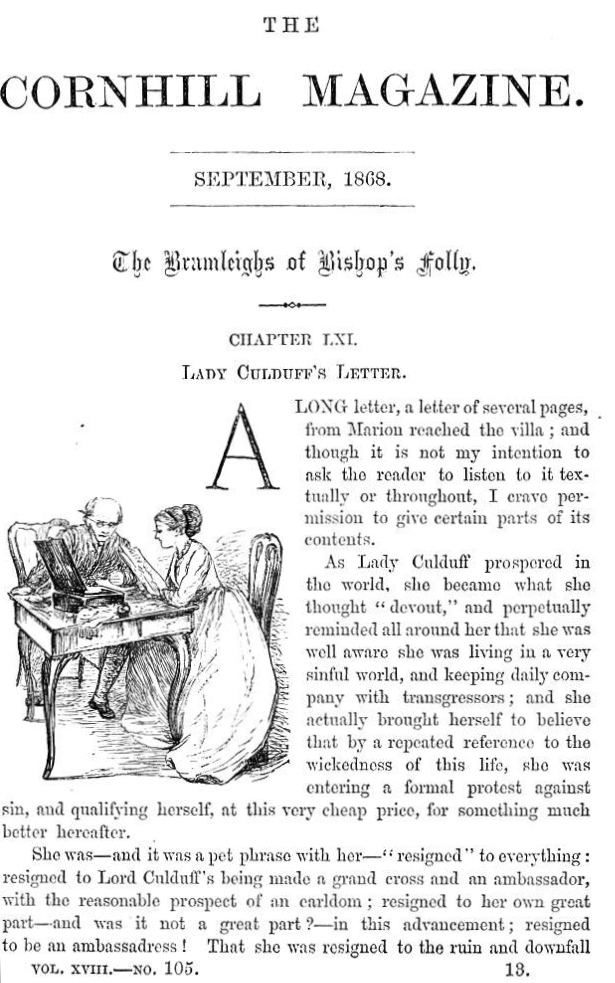

Initial-letter Vignette "T" — Nelly translates documents for Sedley from Italian (Vol. XVIII, page 257) vertically-mounted, 7.5 cm high by 5 cm wide, signed "MEE." in the lower-left corner; also in the lower-left corner of the main illustration. Mary Ellen Edwards' sixteenth thumbnail illustration for the September 1868 number of Lever's The Bramleighs of Bishop's Folly in the Cornhill Magazine, Chapters LVI-LX ("At Lady Augusta's" through "A Return Home") in Vol. 18: pages 257 through 280. The wood-engraver responsible for this illustration was Joseph Swain (1820-1909), noted for his engravings of Sir John Tenniel's cartoons in Punch. [Click on the images to enlarge them.]
This sixteenth vignette apparently introduces the multiple letters of Chapter LXI.
A long letter, a letter of several pages, from Marion, reached the villa; and though it is not my intention to ask the reader to listen to it textually or throughout, I crave permission to give certain parts of its contents.
As Lady Culduff prospered in the world, she became what she thought “devout,” and perpetually reminded all around her that she was well aware she was living in a very sinful world, and keeping daily company with transgressors; and she actually brought herself to believe that by a repeated reference to the wickedness of this life, she was entering a formal protest against sin, and qualifying herself, at this very cheap price, for something much better hereafter. [Chapter LXI, "Lady Cudluff's Letter," 257 in serial; 401 in volume]
However, the balding, middle-aged figure seated across the table across from Nelly, examining some papers, is certainly not Jack. Consequently, the passage realized must in fact be that which opens Chapter LXV, "The Light Stronger," in which, at Augustus's request, Julia L'Estrange translates some documents from Italian for the family attorney, Sedley:
. . . she was seated at the table with Mr. Sedley in the study, an oblong box of oak clasped with brass in front of them, and a variety of papers lying scattered about.
“Have you got good eyes, Miss L'Estrange?” said Sedley, as he raised his spectacles, and turned a peering glance towards her.
“Good eyes?” repeated she, in some astonishment.
“Yes; I don't mean pretty eyes, or expressive eyes. I mean, have you keen sight?”
“I think I have.”
“That's what I need from you at this moment; here are some papers with erasures and re-writings, and corrections in many places, and it will take all your acuteness to distinguish between the several contexts. Aided by a little knowledge of Latin, I have myself discovered some passages of considerable interest. I was half the night over them; but with your help, I count on accomplishing more in half an hour.”
While he spoke he continued to arrange papers in little packets before him, and, last of all, took from the box a painter's palette and several brushes, along with two or three of those quaintly shaped knives men use in fresco-painting. [Chapter LXV, "The Light Stronger," 276 in serial; pp. 423-424 in volume]
Commentary: Unravelling Giacomo Lami's secret from "the oblong box of oak"
Lever's reference to "the box a painter's palette and several brushes" alerts the reader to the contents of the mysterious papers that Cutbill discovered in Chapter LXIV, "A First Gleam of Light." The fresco painter Giacomo Lami was accustomed, apparently, to hide valuables with his tools behind his frescoes, and such has already proven the case with his Flora in Bishop's Folly. The illustrations at the head of the penultimate instalment, the picture of Jack and Cutbill appraising the Lami mural in the Venetian chapel on the grounds of the Villa Fontanella (where the artist was buried) and Sedley's asking Julia for a translation of the Italian papers, set up an anticipation in the reader that the novelist is about to resolve the issue of Pracontal's claim to the Bramleighs' estates. The key phrase that Julia translates from Lami's papers is this: "I have none now to live for — none to work for! Enrichetta, and her boy, gone!" (425 in volume). Old No. 97, "Nick" Baldassare, cannot then be that child, and Pracontal has no claim to the Bramleigh Estates.
Scanned images and text by Philip V. Allingham. [You may use the images without prior permission for any scholarly or educational purpose as long as you (1) credit the person who scanned them and (2) link your document to this URL in a web document or cite the Victorian Web in a print one.]
Bibliography
Lever, Charles. The Bramleighs of Bishop’s Folly. The Cornhill Magazine 15 (June, 1867): pp. 640-664; 16 (July-December 1867): 1-666; 17 (January-June 1868): 70-663; 18 (July-October 1868): 1-403. Rpt. London: Chapman & Hall, 1872. Illustrated by M. E. Edwards; engraved by Joseph Swain.
Stevenson, Lionel. "Chapter XVI: Exile on the Adriatic, 1867-1872." Dr. Quicksilver: The Life of Charles Lever. London: Chapman and Hall, 1939. Pp. 277-296.
Created 6 September 2023